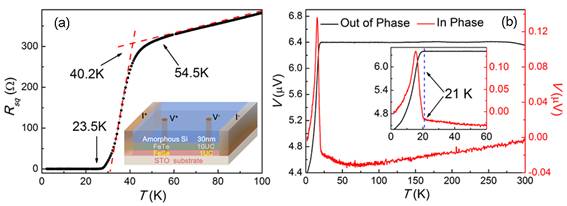Science highlighted Jian Wang and Qi-Kun Xue’s research in Editors' Choice: Direct evidence of the thinnest high temperature superconductors
After almost two years’ great effort, Prof. Jian Wang and Prof. Qi-Kun Xue’s collaboration team firstly demonstrated that the 1-UC thick FeSe films grown on STO substrates are superconducting by direct transport and magnetic measurements, with an onset transition temperature TC above 40 K (Maximum value is 54.5 K) and a critical current density JC ~ 1.7×106 A/cm2 at 2 K, which are much higher than TC ~ 8 K and JC ~ 104 A/cm2 for bulk FeSe. The enhanced superconductivity with high TC, HC2 and JC makes the 1-UC FeSe thin films on high-dielectric STO substrate attractive for potential applications, such as superconducting interconnects, superconducting quantum interference device (SQUID), and field-effect transistor (FET) devices. Since the superconducting layer is only 0.55 nm thick, Wang and Xue’s research demonstrated that the 1-UC FeSe on STO is the thinnest high TC superconductor at present. This work not only paves the way to searching for new high temperature superconductors and enhancing superconductivity by interface engineering, but also offers an ideal platform for understanding the fundamental nature of unconventional superconductivity.
The paper was published in Chinese Physics Letters (CHIN. PHYS. LETT. 31, 017401 (2014)) with a title of “Direct observation of high-temperature superconductivity in one-unit-cell FeSe films” http://cpl.iphy.ac.cn/EN/Y2014/V31/I1/017401 and selected for the Editors’ Choice of Science with a title of “A very thin superconductor” (Science 343, 230 (2014)) http://www.sciencemag.org/content/343/6168/twil.full. This work was supported by the National Basic Research Program of China,the National Natural Science Foundation of China and the Ministry of Education of China .

Figure: Transport and diamagnetic measurements of 1-UC FeSe films grown on SrTiO3 (001). a. The temperature dependence of resistance under zero field. Inset: A schematic structure for the transport measurements in the heterostructure of 30 nm amorphous Si /10-UC FeTe/1-UC FeSe/STO. b. The diamagnetic response measured by a homebuilt two-coil mutual inductance system.